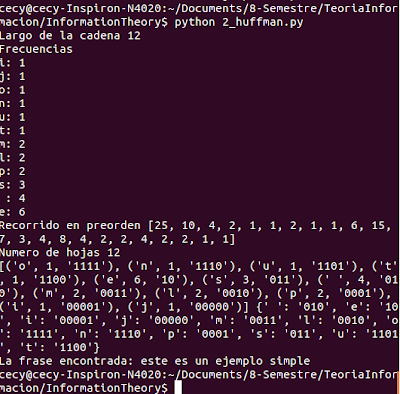For this first part I implemented a binary tree to find the codes for each symbol.
1. The first thing that I did was to create a frequency table.
2. Then I put in pairs the lighter weights until the end of the list.
3. I searched the tree to find the codes for each leaf
I have done a web application to display the Huffman coding in a binary tree, this is the URL:
http://huffmandemo.appspot.com/
And here is the example:
After the decoding algorithm, I did take the text file that I wrote in binary, and I found the equivalent to the tree that I had already done.
This is the example in the terminal encoding and decoding:
Analyze an experiment to determine the worst-case and typical-case complexity and compression ratio
I use texts of 3000 words, for the worst case I have done texts with the same frequency and for the typical case I take random Internet texts
Here I show some plots that I got when I did the experiment:http://huffmandemo.appspot.com/
And here is the example:
After the decoding algorithm, I did take the text file that I wrote in binary, and I found the equivalent to the tree that I had already done.
This is the example in the terminal encoding and decoding:
Analyze an experiment to determine the worst-case and typical-case complexity and compression ratio
I use texts of 3000 words, for the worst case I have done texts with the same frequency and for the typical case I take random Internet texts
 |
| compression ratio |
The complexity of the algorithm is O(nlog n). Since it has an internal loop with logn complexity and then repeated n times, where n is the set of symbols.
And this is the code:
References
Huffman compression
Huffman coding






El mejor caso en realidad no es un caso típico ;) Un caso típico saldría de textos de verdad. Sería bueno guardar lo comprimido en un archivo (binario) para calcular la tasa de compresión en términos de los largos de los archivos de entrada versus salida. Pero está todo bastante bien. Van 7+7 pts.
ResponderEliminar